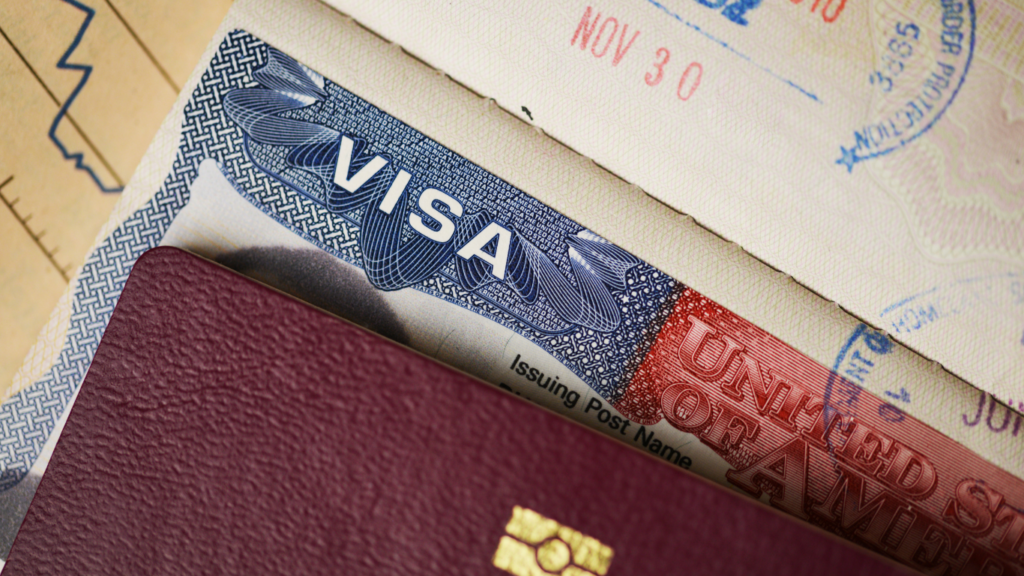ขั้นตอนการสมัครวีซ่า IR1 และ CR1
การสมัครวีซ่าสำหรับคู่สมรสของพลเมืองสหรัฐฯ ประเภท IR1 และ CR1 มีขั้นตอนเดียวกัน โดยมีรายละเอียดดังนี้:
1. ยื่นคำร้อง I-130
1.1 เตรียมเอกสาร:
- กรอกแบบฟอร์ม I-130 (Petition for Alien Relative)
- สำเนาทะเบียนสมรส (รับรองสำเนาถูกต้อง)
- รูปถ่ายตามข้อกำหนด (ตรวจสอบได้ที่ photogov.net)
- หลักฐานการเป็นพลเมืองสหรัฐฯ ของผู้ยื่นคำร้อง (เช่น สำเนาหนังสือเดินทางสหรัฐฯ หรือสูติบัตร)
- หลักฐานการเปลี่ยนชื่อ (ถ้ามี)
1.2 ยื่นคำร้อง:
- ส่งแบบฟอร์ม I-130 และเอกสารประกอบไปยัง USCIS ตามที่อยู่ที่ระบุในคำแนะนำ
1.3 รอการอนุมัติ:
- รอ USCIS ตรวจสอบและอนุมัติคำร้อง (ใช้เวลาประมาณ 6-12 เดือน ขึ้นอยู่กับสถานที่ยื่น)
2. การประมวลผลที่ศูนย์วีซ่าแห่งชาติ (NVC)
2.1 รับเคส:
- เมื่อ I-130 ได้รับการอนุมัติ USCIS จะส่งเคสไปยัง NVC
- NVC ออกหมายเลขเคสและแจ้งผู้ยื่นคำร้องและผู้สมัครทางจดหมายหรืออีเมล
2.2 ชำระค่าธรรมเนียม:
- ชำระค่าธรรมเนียมวีซ่าและค่าธรรมเนียม Affidavit of Support (I-864) ผ่านระบบออนไลน์ของ NVC
3. ยื่นฟอร์ม DS-260
3.1 กรอกแบบฟอร์ม:
- ผู้สมัครกรอกฟอร์ม DS-260 (Immigrant Visa Application) ทางออนไลน์ผ่านเว็บไซต์ของสถานทูต
- ระบุข้อมูลส่วนตัวและรายละเอียดที่จำเป็น
3.2 ส่งเอกสารประกอบ:
- ผู้ยื่นคำร้องส่งแบบฟอร์ม I-864 (Affidavit of Support) พร้อมเอกสาร เช่น ใบภาษีรายปี, หลักฐานการทำงาน, และเอกสารการเงิน
- ผู้สมัครส่งเอกสารส่วนตัว เช่น สูติบัตร, ใบสมรส, ใบรับรองประวัติอาชญากรรม, และรูปถ่ายตามข้อกำหนด
4. การตรวจสอบเอกสาร
4.1 การตรวจสอบ:
- NVC ตรวจสอบเอกสารให้ครบถ้วนและถูกต้อง
- หากขาดเอกสาร NVC จะแจ้งขอเอกสารเพิ่มเติม (Request for Evidence – RFE)
5. นัดหมายสัมภาษณ์
5.1 การนัดหมาย:
- เมื่อเอกสารครบถ้วน NVC ประสานงานกับสถานทูตหรือสถานกงสุลสหรัฐฯ ในประเทศไทยเพื่อกำหนดวันสัมภาษณ์
- ผู้สมัครจะได้รับจดหมายแจ้งวันสัมภาษณ์พร้อมคำแนะนำการเตรียมตัว
6. ตรวจสุขภาพและสัมภาษณ์
6.1 ตรวจสุขภาพ:
- ผู้สมัครตรวจสุขภาพกับแพทย์ที่สถานทูตรับรอง (เช่น โรงพยาบาลบีเอ็นเอช หรือบำรุงราษฎร์)
6.2 สัมภาษณ์:
- เข้ารับการสัมภาษณ์ที่สถานทูตหรือสถานกงสุลสหรัฐฯ
- ตอบคำถามเกี่ยวกับข้อมูลส่วนตัว ความสัมพันธ์ และแผนการในสหรัฐฯ
7. การออกวีซ่า
7.1 การออกวีซ่า:
- หากผ่านการสัมภาษณ์และเอกสารครบถ้วน จะได้รับวีซ่าผู้อพยพ (IR1 หรือ CR1)
8. เดินทางไปสหรัฐฯ และปรับสถานะ
8.1 การเดินทาง:
- เดินทางเข้าสหรัฐฯ และผ่านด่านตรวจคนเข้าเมือง
8.2 ปรับสถานะ:
- ผู้ถือวีซ่า CR1 ต้องยื่นแบบฟอร์ม I-751 (Petition to Remove Conditions on Residence) เพื่อเปลี่ยนเป็นสถานะถาวรภายใน 90 วันก่อน Green Card 2 ปีหมดอายุ
ความแตกต่างระหว่าง IR1 และ CR1
IR1 (Immediate Relative Visa)
- เงื่อนไข: คู่สมรสแต่งงานกันมานานกว่า 2 ปี ณ วันที่วีซ่าอนุมัติ
- สถานะ: ได้รับสถานะผู้อยู่อาศัยถาวรทันที และ Green Card อายุ 10 ปี
CR1 (Conditional Resident Visa)
- เงื่อนไข: คู่สมรสแต่งงานกันน้อยกว่า 2 ปี ณ วันที่วีซ่าอนุมัติ
- สถานะ: ได้รับสถานะชั่วคราว และ Green Card อายุ 2 ปี ต้องยื่น I-751 เพื่อเปลี่ยนเป็นสถานะถาวรก่อน Green Card หมดอายุ
Steps to Apply for IR1 and CR1 Visas
The application process for IR1 and CR1 visas for spouses of U.S. citizens follows the same steps, with the following details:
1. Filing the I-130 Petition
1.1 Prepare Documents:
- Complete Form I-130 (Petition for Alien Relative)
- Copy of marriage certificate (certified copy)
- Passport-style photos meeting requirements (check at photogov.net)
- Proof of U.S. citizenship for the petitioner (e.g., copy of U.S. passport or birth certificate)
- Evidence of name change (if applicable)
1.2 Submit the Petition:
- Send Form I-130 and supporting documents to USCIS at the address specified in the instructions
1.3 Await Approval:
- Wait for USCIS to review and approve the petition (takes approximately 6-12 months, depending on the filing location)
2. Processing at the National Visa Center (NVC)
2.1 Case Receipt:
- Once the I-130 is approved by USCIS, the case is transferred to the NVC
- NVC assigns a case number and notifies the petitioner and applicant via letter or email
2.2 Pay Fees:
- Pay the visa processing fee and the Affidavit of Support (I-864) fee online through the NVC system
3. Submit Form DS-260
3.1 Complete the Form:
- The applicant completes Form DS-260 (Immigrant Visa Application) online via the U.S. Embassy website
- Provide personal information and other required details
3.2 Submit Supporting Documents:
- The petitioner submits Form I-864 (Affidavit of Support) with required documents, such as annual tax returns, proof of employment, and financial records
- The applicant submits personal documents, such as a birth certificate, marriage certificate, police clearance certificate, and passport-style photos
4. Document Review
4.1 Verification:
- NVC reviews all documents to ensure they are complete and accurate
- If documents are missing, NVC will request additional evidence (Request for Evidence – RFE)
5. Schedule an Interview
5.1 Appointment:
- Once all documents are verified as complete, NVC coordinates with the U.S. Embassy or Consulate in Thailand to schedule an interview
- The applicant receives an interview appointment letter with preparation instructions
6. Medical Examination and Interview
6.1 Medical Examination:
- The applicant undergoes a medical examination with a doctor approved by the U.S. Embassy (e.g., BNH Hospital or Bumrungrad International Hospital)
6.2 Interview:
- The applicant attends an interview at the U.S. Embassy or Consulate
- The interviewer asks questions about personal details, the relationship with the petitioner, and plans in the U.S.
7. Visa Issuance
7.1 Visa Issuance:
- If the interview is successful and all documents are complete, the applicant receives an immigrant visa (IR1 or CR1)
8. Travel to the U.S. and Status Adjustment
8.1 Travel:
- Travel to the United States and pass immigration inspection at the port of entry
8.2 Status Adjustment:
- For CR1 visa holders, file Form I-751 (Petition to Remove Conditions on Residence) to adjust to permanent status within 90 days before the 2-year Green Card expires
Differences Between IR1 and CR1
IR1 (Immediate Relative Visa)
- Condition: For spouses married for more than 2 years as of the visa approval date
- Status: Receives permanent resident status immediately and a 10-year Green Card
CR1 (Conditional Resident Visa)
- Condition: For spouses married for less than 2 years as of the visa approval date
- Status: Receives conditional resident status and a 2-year Green Card; must file Form I-751 to adjust to permanent status before the Green Card expires



